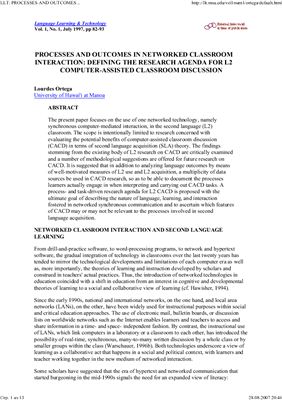Language Leaing & Technology, Vol. 1, No. 1, July 1997, pp
82-93
ABSTRACT
The present paper focuses on the use of one networked technology, namely synchronous computer-mediated interaction, in the second language (L2) classroom. The scope is intentionally limited to research conceed with evaluating the potential benefits of computer-assisted classroom discussion (CACD) in terms of second language acquisition (SLA) theory. The findings stemming from the existing body of L2 research on CACD are critically examined and a number of methodological suggestions ar e offered for future research on CACD. It is suggested that in addition to analyzing language outcomes by means otivated measures of L2 use and L2 acquisition, a multiplicity of data sources be used in CACD research, so as to be able to document the processes leaers actually engage in when interpreting and carrying out CACD tasks. A process- and task-driven research agenda for L2 CACD is proposed with the ultimate goal of describing the nature of language, leaing, and interaction fostered in networked synchronous communication and to ascertain which features of CACD may or may not be relevant to the processes involved in second language acquisition.
ABSTRACT
The present paper focuses on the use of one networked technology, namely synchronous computer-mediated interaction, in the second language (L2) classroom. The scope is intentionally limited to research conceed with evaluating the potential benefits of computer-assisted classroom discussion (CACD) in terms of second language acquisition (SLA) theory. The findings stemming from the existing body of L2 research on CACD are critically examined and a number of methodological suggestions ar e offered for future research on CACD. It is suggested that in addition to analyzing language outcomes by means otivated measures of L2 use and L2 acquisition, a multiplicity of data sources be used in CACD research, so as to be able to document the processes leaers actually engage in when interpreting and carrying out CACD tasks. A process- and task-driven research agenda for L2 CACD is proposed with the ultimate goal of describing the nature of language, leaing, and interaction fostered in networked synchronous communication and to ascertain which features of CACD may or may not be relevant to the processes involved in second language acquisition.

